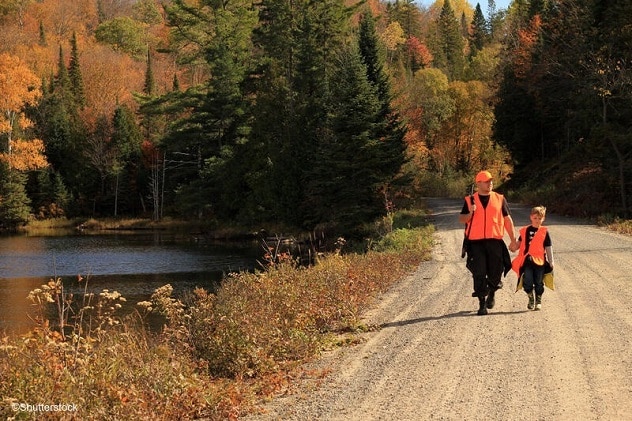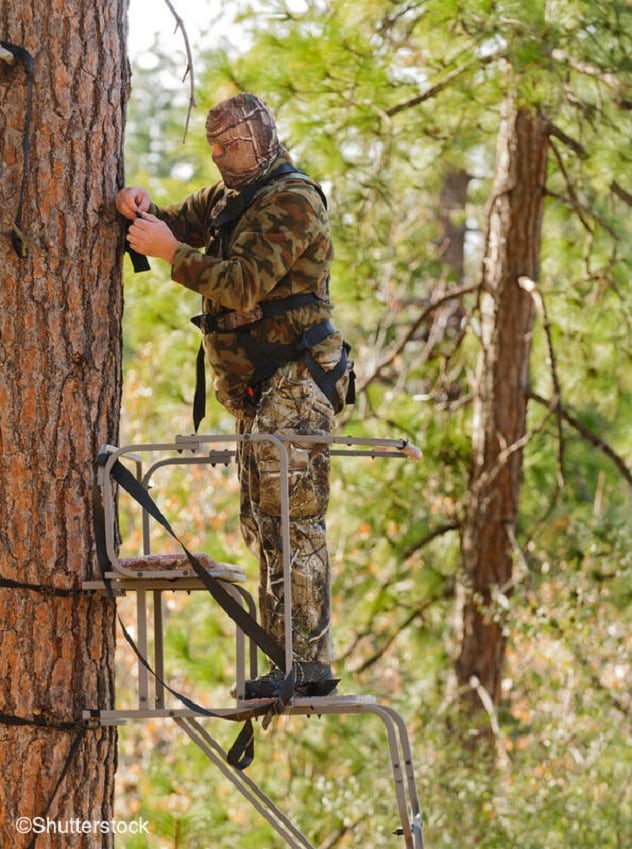Oct. 01, 2024
 Bow hunting
Bow hunting
A father and son bow hunt in the fall.
 Tree stand
Tree stand
Bow hunter in a ladder-style tree stand attaching a fall arrest harness to a strap around the tree.
As the summer moves into fall, hunters in Southern Minnesota, Western Wisconsin and Northern Iowa gear up for deer hunting. This season begins with bow hunting followed by firearms. Deer hunting season also comes with a potential injury source: tree stands.
According to an online article from the Minnesota Department of Natural Resources (DNR), 1 in 3 hunters who use a tree stand falls. Annually, 6,400 accidental tree stand injuries occur in the U.S.
Henry J. Schiller, M.D., a trauma surgeon at Mayo Clinic in Minnesota, estimates the number of hunters who fall to be even higher, as some experience less serious falls and do not seek medical attention. Therefore, falls go unreported.
To prevent tree stand injury, it is crucial to disseminate injury prevention tips to your community. Target your efforts toward locations likely to attract hunters, such as sporting goods stores, gun clubs or archery ranges.
Dr. Schiller suggests visiting the Minnesota DNR webpage on tree stand safety. He also highlights these suggestions:
- Enroll in a safety course. Take a DNR safety or bow hunter education course in your area. Pay attention during class and read all materials.
- Don't neglect a fall arrest system. Use appropriate restraint devices and keep the harness tight enough to avoid a long drop and injury, such as severing an extremity in a tree fall.
- Heed the three-point rule. While climbing or descending, always maintain three contact points with the ladder.
- Be judicious about where you sit. Never trust a tree stand someone else put up. Inspect a tree stand before putting your full weight on it.
- Use a well-built stand. Homemade, improvised tree stands are typically less safe than commercial stands. Read the installation instructions.
- Have a means of communication. If you fall and cannot call for help, you are at risk of fatality. Be prepared by bringing along a cellphone, flare, horn or other signaling device. Tell others where you will be hunting before you go.
A 2022 study published in Southern Medical Journal determined the No. 1 cause of deer hunting injury in Pennsylvania to be tree stand falls: Between 1990 and 2017, the Pennsylvania Trauma Systems Foundation registry recorded 1,229 tree stand falls. While noting that these falls typically were not fatal, the authors indicated frequent polytrauma and disabling injury. They also found structural failure accounted for 57% of tree stand falls.
This study also found the average tree stand height was 5 meters (about 16 feet). The Minnesota DNR's tree stand height recommendation is under 10 feet.
"The higher you are, the greater the force if you fall," says Dr. Schiller. "The lethal height resulting in death for 50% of victims who fall is about 20 feet."
The Southern Medical Journal study also found tree stand injuries occurred more often than hunting-related shootings in Pennsylvania. Nationally, injury rates from both hunting-related sources have remained approximately the same, says Dr. Schiller.
In addition, the study found 23% of tree stand falls resulted in single injuries, and 77% resulted in multiple injuries: 50 with chest injuries, 70 with lumbar injuries and 35 with thorax injuries.
Though it's uncommon for hunters who fall from tree stands to die — the fatality rate is 0.8% — 28% of those injured had injury severity scores of over 15, indicating severe injury, and 26% had functional limitations when discharged, according to this study.
"For a working-age population, that is significant," says Dr. Schiller, noting that tree stand injuries are almost entirely preventable.
A common scenario for patients with tree stand-related trauma
Dr. Schiller indicates while none of his acquaintances have been injured using tree stands, he has treated patients who have fallen from them.
"Every year, I see patients who have spinal injuries and paralysis from tree stand falls," he says. "Most are lower extremity injuries, often to the hip, especially as the instinct of the hunter who falls is to land on their feet."
A typical patient Dr. Schiller sees in the trauma bay with tree stand injuries while hunting is a 40- to 45-year-old male. He says these patients typically say they fell asleep in the tree stand, leading to a fall, and often have alcohol in their systems.
Tiredness is not an unusual phenomenon for deer hunters, notes Dr. Schiller.
"Hunting starts one half-hour before sunrise and ends one-half hour after sunset," he says. "I wasn't in a deer stand — rather a hunting stool — and I was so tired, I fell asleep. I know other hunters who've fallen asleep against a tree."
Drinking alcohol also is common on hunting trips, says Dr. Schiller.
"People shouldn't drink right before hunting, but they do," he says.
The combination of alcohol and fatigue also puts hunters at greater risk of tree stand falls, he indicates.
"If hunters are out with friends, they go to a cabin, and then it's often time for beer and whiskey," he says. "Then morning comes, and you're pretty tired."
Dr. Schiller also says most patients he's seen for tree stand falls did not use a harness, which increases fall risk if the hunter falls asleep. Dr. Schiller also notes he has witnessed in his practice that many hunters go out alone, so if a fall occurs, a delay in care occurs due to difficulty contacting help.
Treating tree stand injuries
If a hunter arrives at your trauma center after a tree stand fall, Dr. Schiller suggests:
- Stabilize the patient; follow the trauma protocol of attending to the airway, breathing and circulation.
- Conduct complete spinal imaging for patients who have fallen 10 feet or more.
- Anticipate the patient has multiple injuries.
- Avoid distraction from the patient's other injuries, which can occur even with trained medical professionals if the patient focuses on one obvious injury.
- Arrange a telemedicine consult with the on-call eConsult physician at Mayo Clinic's emergency department.
- Transfer the patient to a higher care level immediately if you realize the injuries require it. If there is potential for spinal injury, immobilize the patient's spine.
- Keep and treat the patient if your trauma center has resources to address the patient's injuries.
For more information
Tree stand safety. Minnesota Department of Natural Resources.
Hunter education & safety. Minnesota Department of Natural Resources.
Young, KA. Falls from tree stands have become the leading cause of deer hunting accidents in Pennsylvania. Southern Medical Journal. 2022; 115: 745.
Refer a patient to Mayo Clinic.